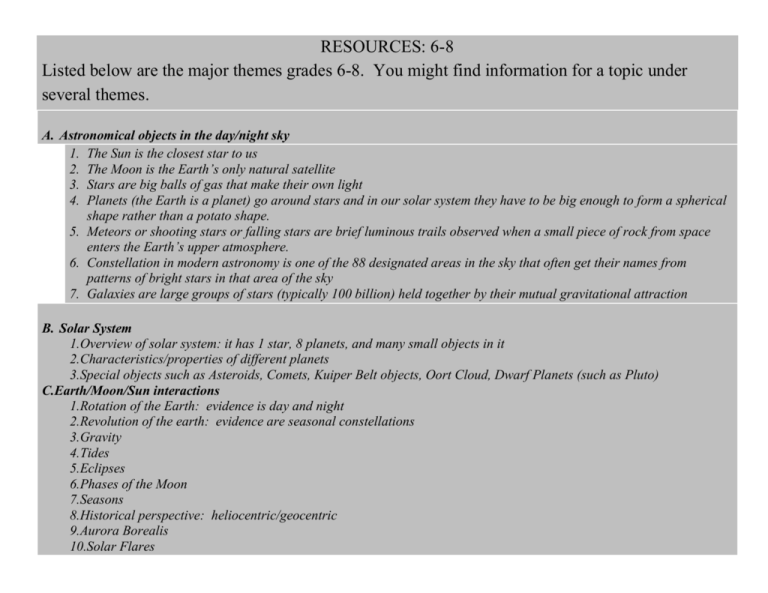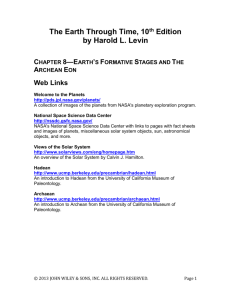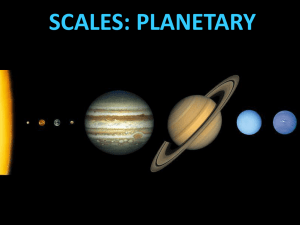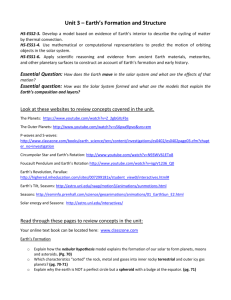RESOURCES: 6-8
advertisement

RESOURCES: 6-8 Listed below are the major themes grades 6-8. You might find information for a topic under several themes. A. Astronomical objects in the day/night sky 1. The Sun is the closest star to us 2. The Moon is the Earth’s only natural satellite 3. Stars are big balls of gas that make their own light 4. Planets (the Earth is a planet) go around stars and in our solar system they have to be big enough to form a spherical shape rather than a potato shape. 5. Meteors or shooting stars or falling stars are brief luminous trails observed when a small piece of rock from space enters the Earth’s upper atmosphere. 6. Constellation in modern astronomy is one of the 88 designated areas in the sky that often get their names from patterns of bright stars in that area of the sky 7. Galaxies are large groups of stars (typically 100 billion) held together by their mutual gravitational attraction B. Solar System 1.Overview of solar system: it has 1 star, 8 planets, and many small objects in it 2.Characteristics/properties of different planets 3.Special objects such as Asteroids, Comets, Kuiper Belt objects, Oort Cloud, Dwarf Planets (such as Pluto) C.Earth/Moon/Sun interactions 1.Rotation of the Earth: evidence is day and night 2.Revolution of the earth: evidence are seasonal constellations 3.Gravity 4.Tides 5.Eclipses 6.Phases of the Moon 7.Seasons 8.Historical perspective: heliocentric/geocentric 9.Aurora Borealis 10.Solar Flares 11.Climate, weather, etc. D. Constellations 1.Sky maps and stargazing 2.Modern 88 official constellations, Seasonal versus Circumpolar constellations, and Basic constellations E.Life of a Star 1.How do stars live? 2.Stellar corpses: black holes, neutron stars 3. HR Diagram F.Forces and physical properties 1.Gravity 2.Inertia G. Space Exploration H. History of NASA I. Big Bang Theory and Cosmology J. Exoplanets K. Extraterrestrial Intelligence A. Theme: Astronomical (celestial) objects in the day and night sky 1. The Sun is the closest star to us Basic information, activities and videos on the Sun. http://www.youtube.com/watch?v=1Swmddp6GKg&feature=related Video-/ Space school- great overview information http://www.solarweek.org/cms/ (SOLAR Week Good overall activities and information) http://www.lmsal.com/YPOP/Classroom/Lessons/Cycles/puzzlemedi.html Activity on solar images- 8th grade and up) http://spaceplace.nasa.gov/external/http://www.nasa.gov/vision/universe/solarsystem/sun_for_kids_main.html (NASA 10 facts about the sun) http://www.windows2universe.org/space_weather/sw_gallery/sw_movie_gallery.html Windows2UniverseVideo clips (Upper level) about the Sun http://solar-center.stanford.edu/about/ - Stanford-Good overall Activities and Information http://www.lmsal.com/YPOP/Classroom/Lessons/Cycles/puzzlepix.html#choices Solar Image Activity (using data – 8th grade and up) http://lasp.colorado.edu/education/space_weather/lessons.html#middle (2 Lessons- click on Dynamic Nature of the Sun Video: Bill Nye- Sun largest object in solar system http://www.youtube.com/watch?v=XsmShFLTTI4&playnext=1&list=PLC6517B7F3D66042C Activity: “How can the Sun and the Moon appear to be the same size?” http://www.kidseclipse.com/pages/a1b3c2d1.htm Images concerning Parts of the Sun: http://fusedweb.pppl.gov/CPEP/Chart_pages/5.Plasmas/SunLayers.html http://www.cosmographica.com/gallery/infographics/solar_anatomy.html http://www.solarviews.com/eng/sun.htm (Image in middle of the page) http://www.universetoday.com/18421/diagram-of-the-sun/ (Image for 8th grade and up) 2. Moon is the Earth’s only natural satellite http://www.nasa.gov/audience/foreducators/topnav/materials/listbytype/Exploring.the.Moon.html (NASA-Impact Craters page 61 activity. gr.512 downloadable guide with activities on exploring the Moon.) http://stardate.org/nightsky/moon (Moon phase calendar) 3. Stars are big balls of gas that make their own light http://www.windows2universe.org/cool_stuff/tourstars_1a.html (Windows2Universe-slideshow tour) (Also check “Life of Stars in section below) 4. Planets (the Earth is a planet) go around stars and in our solar system they have to be big enough to form a spherical shape rather than a potato shape http://spaceplace.nasa.gov/how-orbits-work/redirected/ NASA Interactive simulation concerning gravity and orbits http://www.windows2universe.org/our_solar_system/planets.html (Information on the planets) 5. Meteors or shooting stars or falling stars are brief luminous trails observed when a small piece of rock from space enters the Earth’s upper atmosphere. http://stardate.org/nightsky/meteors (Meteor shower calendar) http://www.jpl.nasa.gov/multimedia/neo/spaceRocks.html (NASA Interactive website on meteors, asteroids, and other Near Earth Objects. Click on bottom tabs to move to different layers of website) 6. Constellation in modern astronomy is one of the 88 designated areas in the sky that often get their names from patterns of bright stars in that area of the sky http://www.classzone.com/books/earth_science/terc/content/visualizations/es0407/es0407page01.cfm?chapter_no=visualization Classzone Applet – movement of constellations across the sky 7. Galaxies are large groups of stars (typically 100 billion) held together by their mutual gravitational attraction http://seds.org/messier/galaxy.html (Teacher information on galaxies) http://hubblesite.org/gallery/album/galaxy (Hubble Image gallery) collision http://www.windows2universe.org/the_universe/Milkyway.html (Windows2Universe- Information for teachers) http://zoo1.galaxyzoo.org/ (Galaxy Zoo- Citizen identification project and interactive project utilizing real data) B. Theme: Solar System 1. Overview of solar system: it has 1 star, 8 planets, and many small objects in it Activity: “Solar System in your Pocket” to show the relative distances between the Sun and the planets. http://www.ecotarium.org/activities/try-it-at-home/PocketSolSys.pdf The Sun is located at the center of our solar system http://www.kidsastronomy.com/solar_system.htm (6th grade and lower) Kids Astronomy shows Sun at center of solar system as well as info on planets. 2. Characteristics/properties of different planets. How do we know the physical properties of a planet? Planet information http://www.windows2universe.org/our_solar_system/solar_system_1.html (Windows2Universe Planet pictures/ information) http://solarsystem.nasa.gov/planets/ (NASA Information) http://www.exploratorium.edu/ronh/solar_system/index.html. (Activity: You can find the correct relative distances to planets by consulting. For older kids, you can have them calculate the distances for a certain scale. Younger kids provide the numbers) http://lasp.colorado.edu/education/outerplanets/giantplanets.php (Information on the outer planets for upper level.) http://www.kidsastronomy.com/solar_system.htm (Kids Astronomy Interactive website-click on left side to learn about each planet) http://lasp.colorado.edu/education/space_weather/files/middle/Earth_as_Magnet.pdf (Activity on Earth as a magnet) http://www.space.com/9737-kingdoms-giants-realms-jupiter-saturn.html (Space.com Video- Search Kingdoms of the Giants) http://marsed.mars.asu.edu/marsbound (ASU realistic planning mission to Mars appropriate for 8th grade) http://solarsystem.nasa.gov/eyes/ (NASA Interactive, 3-D website- travel to different planets- NASA) http://www.space.com/12349-mars-eyes-spirit-montage.html (Space.com Video –Search -Mars through the eyes Spirit) 3. Special objects such as Asteroids, Comets, Kuiper Belt objects, Oort Cloud, Dwarf Planets (such as Pluto) http://lasp.colorado.edu/education/outerplanets/kbos.php (Website on Kuiper Belt objects and outer planets) http://www.jpl.nasa.gov/education/index.cfm?page=214 (NASA website on- comets) http://www.jpl.nasa.gov/multimedia/neo/spaceRocks.html (NASA Self-Guided website on comets, meteors, asteroids, excellent) http://sese.asu.edu/teacher-resources (ASU Activities on comets- Look for EPOXI NASA MISSION - IN THE MIDDLE of page) 4. Formation of the Solar System Information on the “formation” of solar system-LASP http://lasp.colorado.edu/education/outerplanets/solsys.php C. Theme: Earth/Moon/Sun Interactions 1. 1. Rotation of the earth: evidence is day and night Video for Teacher Usagehttp://www.youtube.com/watch?v=lkWyM-M8o0c Video -Earth moves in a helical motion around the Sun as it travels through our galaxy Classzone Applet-Earth rotates on a tilted axis every 24 hrs. Explore a model of this rotation: http://www.classzone.com/books/earth_science/terc/content/visualizations/es0404/es0404page01.cfm?chapter_no=visualization Kids Astronomy-Sun’s location-http://www.kidsastronomy.com/solar_system.htm Classzone Applet-: evidence that Earth turns on an axis http://www.classzone.com/books/earth_science/terc/content/visualizations/es0403/es0403page01.cfm?chapter_no=visualization 2. Revolution of the earth: evidence are seasonal constellations http://www.classzone.com/books/earth_science/terc/content/visualizations/es0408/es0408page01.cfm?chapter_no=04 Classzone Applet Earth revolves around Sun. Video on “What Causes the Seasons?” http://www.youtube.com/watch?v=DuiQvPLWziQ 3. Gravity 1. Activities: http://www.csr.utexas.edu/grace/education/activities/gravity.html Activities (4) for gravity at grades 6-8) http://spaceplace.nasa.gov/how-orbits-work/redirected/ NASA Applet-simulation on orbits and gravity http://spaceplace.nasa.gov/what-is-gravity/en/ Information on gravity- NASA 4. Tides http://www.mbgnet.net/salt/sandy/index.htm (Information on tides- left side of screen) http://www.asc-csa.gc.ca/eng/educators/resources/astronomy/multimedia/module3/tides/using_applet.asp (Interactive Applet of why Earth experiences tides from Canada Space Agency- upper level) 5. Eclipses http://www.kidseclipse.com/pages/a1b3c1d0.htm (Kids Eclipse-Simulation: Click on activity. 1. http://www.youtube.com/watch?v=H8s8EhShCDY Video clip (Partial solar eclipse Jan. 2011 from around the world) http://www.youtube.com/watch?v=XMyqPxFh5Zw&feature=related Video clip (Total solar eclipse) http://www.youtube.com/watch?v=eBp0kOscLjw Video clip (Lunar eclipse) LRO/NASA narrated and detailed 6. Phases of the Moon Activity one NASA - phases of the Moon: http://www.jpl.nasa.gov/education/index.cfm?page=123 Activity two Windows2Universe- phases of the Moon: http://www.windows2universe.org/teacher_resources/lunar_edu.html (more in-depth lesson plan) Moon Observation Journal Activity - https://planetariumweb.madison.k12.wi.us/files/planetarium/observing_the_moon.pdf 7. Seasons http://www.youtube.com/watch?v=DuiQvPLWziQ Video: What causes Earth’s Seasons? Light and Darkness Hours Applets on seasons and other interactions: http://www.mogi-vice.com/Pagine/Downloads.html 1. (Activity- a good basic lesson from MN Science Teacher Education Project) http://serc.carleton.edu/sp/mnstep/activities/25681.html (Challenger Center for Space Education- A more In depth Activity) http://www.challenger.org/lessons/37.pdf 8. Historical perspective: heliocentric/geocentric Heliocentric/geocentric video information http://www.youtube.com/watch?v=iiBIFlvu-X0 9. Aurora Borealis http://ds9.ssl.berkeley.edu/auroras/story.html (Powerpoint Berkeleyfor lower 6th grade students) http://lasp.colorado.edu/education/dancinglights/media/dancingLights.html Musical Powerpoint with beautiful images to introduce topic http://lasp.colorado.edu/education/dancinglights/docs/Aurora.pdf (LASP Powerpoint) http://www.exploratorium.edu/learning_studio/auroras/selfguide1.html (Information and images) http://lasp.colorado.edu/education/space_weather/lessons.html#middle (LASP Activities on Aurora Borealis-under “Space Weather-Middle School and Where to see an Aurora?” 10. Solar Flares http://www.solarweek.org/cms/ (Solar Week Activities on solar flares) http://sunearthday.nasa.gov/2011/multimedia/solar_storms.php (Multimedia NASA presentation on Solar Storms-Under Monday “Learn about the Sun as a star. Tuesday- Drawing sunspots from an image ) http://eo.ucar.edu/educators/ClimateDiscovery/LIA_lesson7_9.28.05.pdf (Activity-Sunspot graphing activity) http://lasp.colorado.edu/education/space_weather/lessons.html#middle LASP Activity AM Radio Ionosphere Station) http://www.youtube.com/v/DSfAI6_7bjU?fs=1&hl=en_US&rel=0 Great video on space weather 11. Climate, weather, etc. http://climatewisconsin.org/ (Multi-Media- 5th grade and older) Vignettes of how climate change is impacting different WI locals and residents http://carboncycle.aos.wisc.edu/ (Information and Applet for Teacher -global climate change – 8th grade and up) http://spaceplace.nasa.gov/greenhouse/en/ (Activity NASA: Green house gases with gummies-found at bottom of page) http://lasp.colorado.edu/education/climate_change/ (8 Activities (grades 6-8) on Global Climate Change) D. Theme: Constellations 1. Modern 88 official constellations, Seasonal versus circumpolar, and some Basic Constellations http://www.windows2universe.org/the_universe/Constellations/circumpolar.html (Windows2Universe -Information on circumpolar constellations) http://www.windows2universe.org/the_universe/Constellations/constnavi.html (Windows2Universe info and multimedia on constellations) http://stardate.org/sites/default/files/pdfs/teachers/ModelTheNightSky.pdf (Activity- listed K-5: could work lower 6th grade on modeling the night sky- zodiac constellations) http://www.tsgc.utexas.edu/space_vision/constellations.pdf (Graphing constellation coordinates from Texas Space Grant ) http://www.classzone.com/books/earth_science/terc/content/visualizations/es0407/es0407page01.cfm?chapter_no=visualization (Classzone Simulation: movement of constellations across sky 2. Sky maps and stargazing http://amazing-space.stsci.edu/tonights_sky/ Video of Sky Map http://www.skymaps.com/downloads.html Star Maps (look at the top for the free downloads at top of the page) E. Theme: Life of a Star 1. How do stars live? Summary of life of a star- NASA http://science.nasa.gov/astrophysics/focus-areas/how-do-stars-form-and-evolve/ Interactive site on how stars live -8th and older (see sections on bottom): http://lasp.colorado.edu/education/outerplanets/solsys_star.php 2. Stellar corpses: black holes, neutron stars 1. Stellar corpses: black holes, neutron stars http://www.windows2universe.org/the_universe/BH.html (Information-Windows2Universe on black holes) http://www.space.com (Video from space.com- Go to SEARCH tab- type in “Black Holes: Warping Time and Space) http://hubblesite.org/explore_astronomy/black_holes/ Information from Hubble on black holes. See “Journey to Black Hole” 3. HR Diagram http://www.noao.edu/education/jewels/home.html (Activity upper middle level) http://www.mhhe.com/physsci/astronomy/applets/Hr/frame.html (Interactive- advance -G/T 8th-students can see animation) http://outreach.atnf.csiro.au/education/senior/cosmicengine/stars_hrdiagram.html (Overview of HR – 8th advanced) F. Theme: Forces and physical properties 1. Gravity http://www.csr.utexas.edu/grace/education/activities/gravity.html (Activities (4) lessons Gravity Recover and Climate 2. Inertia http://www.youtube.com/watch?v=8zsE3mpZ6Hw Video Clip on inertia http://www.youtube.com/watch?v=Q0Wz5P0JdeU Video Clip on Inertia that is exciting and has more detail G. Theme: Space Exploration http://www.tsgc.utexas.edu/spaceexplorers/activities/Blastoff.pdf (Activity rocket building) http://www.space.com (Video Space.com- Go to SEARCH tab- type in Mars through the Eyes of Spirit H. Theme: History of NASA http://www.NASA.gov/missions NASA missions on left: current, past, and future\ I. Theme: Big Bang Theory and Cosmology http://www.youtube.com/watch?v=nVsHjnY-o9s&feature=related (Video on description of the Big Bang from National Geographic) http://map.gsfc.nasa.gov/universe/bb_tests.html (NASA -Information on Evidence for Big Bang. 8th grade and up) J. Theme: Exoplanets http://lasp.colorado.edu/education/outerplanets/exoplanets.php (LASP - Website Information. Starting overview of detection methods) http://kepler.nasa.gov/ (Click on Notable Discoveries from Kepler -8th and up K. Theme: Extraterrestrial Intelligence http://www.bing.com/videos/search?q=Communication+with+Extraterrestrial+Intelligence+%2b+SETI&view=detail&mid=2F63BA9C52D6F4753 76E2F63BA9C52D6F475376E&first=0&FORM=LKVR1 (Video clip on SETI) http://www.bing.com/videos/search?q=SETI+%2b+Carl+sagan&view=detail&mid=E4E598B6133A5DB1E5BAE4E598B6133A5DB1E5BA&first =0&FORM= (Video clip from Carl Sagan’s Cosmos Series) Books 4th -8th grade The Magic School Bus Space Explorers, Joanna Cole The Solar System, Cathy Imhoff Following the Drinking Gourd, Jeanette Winter The Usbourne Internet-Linked Book of Astronomy and Space, Lisa Miles and Alastair Smith Black Holes and Other Space Phenomena, Young Observer Nature Activities Star Gazer , Ben Morgan 1000 Facts About Space, Pam Beasant








